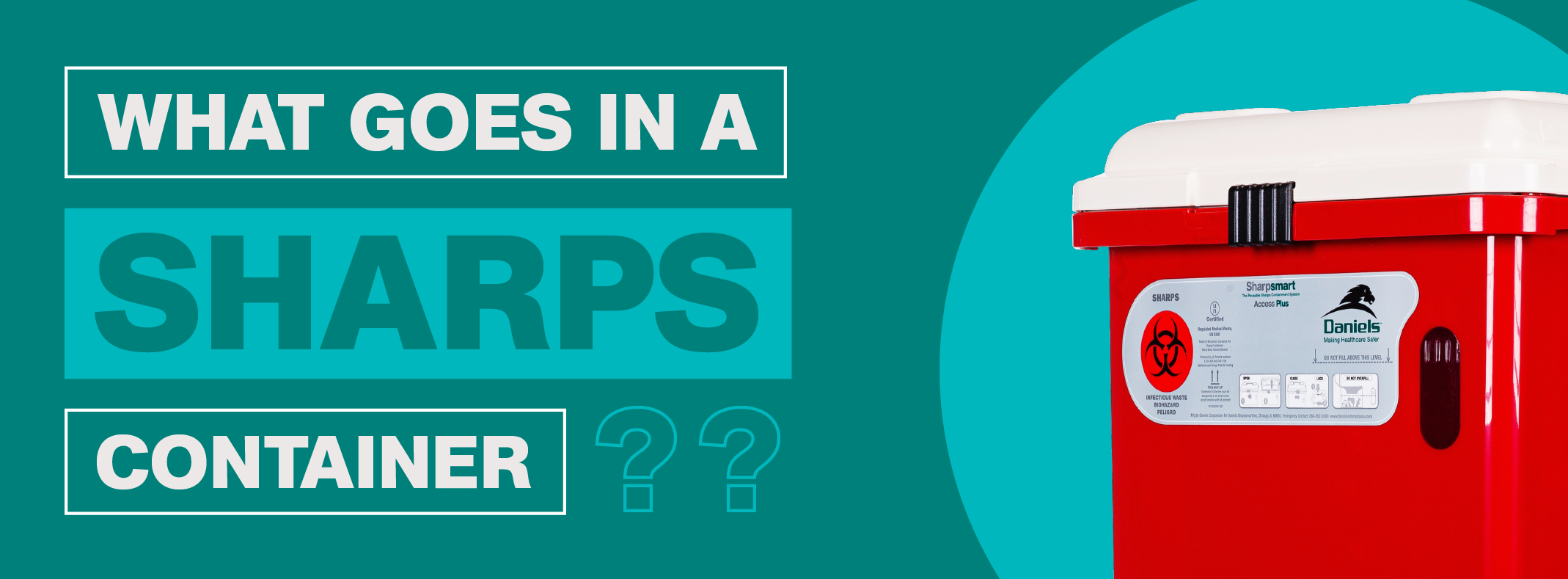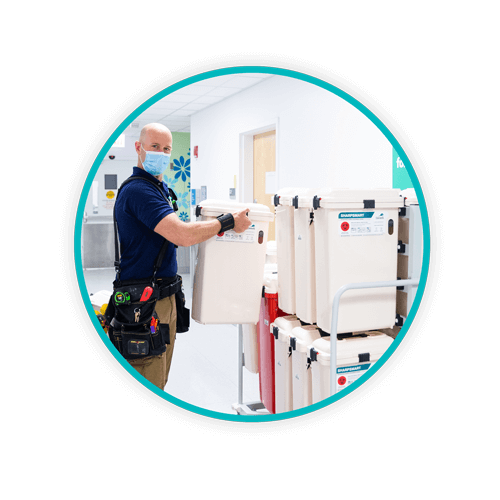What Goes in a Sharps Container?

Understanding what goes into a sharps container is crucial for healthcare safety and compliance. Review the basics to ensure safe disposal procedures.
TOPICS WE WILL COVER:
1 / The Importance of Knowing How to Dispose of Sharps Containers
2 / What Goes in a Sharps Container
3 / What Not to Put in Sharps Containers
4 / What Should You Do Before Disposing of Needles in Sharps Containers?
5 / Introducing The Sharpsmart Range
6 / Get Started With Our Professional Services
The Importance of Knowing How to Dispose of Sharps Containers

Understanding how to dispose of sharps containers is crucial in healthcare settings to prevent severe health risks and ensure environmental safety. Improper disposal can lead to dangerous exposures to infectious diseases such as HIV, Hepatitis B, and Hepatitis C, primarily through needlestick injuries. These incidents not only pose significant health threats to healthcare workers but can also involve costly medical treatments and legal implications. Moreover, incorrect disposal practices can lead to environmental pollution, posing further risks to public health and safety. By adhering to proper disposal methods, healthcare facilities can maintain a safer environment for both their staff and the broader community.
What Goes in a Sharps Container
According to the OSHA Bloodborne Pathogens standard, sharps are objects that have the ability to penetrate a worker’s skin, such as needles, scalpels, broken glass, capillary tubes, and exposed ends of dental wires. If these objects are contaminated with blood or other potentially infectious materials (OPIM), they are classified as contaminated sharp objects, necessitating the use of appropriate personal protective equipment during handling.
Common Items
Medical instruments like needles, scalpels, and lancets are examples of sharps. These instruments are integral to various medical procedures but require careful disposal to prevent health risks, such as bloodborne pathogen transmission. Proper disposal practices are essential to avoid exposure to infections and ensure that these potential hazards are securely contained.
Handling Connected Devices
It is critical not to remove, recap, or bend needles attached to syringes. The best practice is to place the entire connected device into the sharps container immediately. This practice minimizes the chances of sharps injuries and maintains a safe environment for healthcare providers and patients. For more details on proper disposal practices, refer to the CDC’s guidelines on sharps disposal.
What Not to Put in Sharps Containers
It’s important to recognize that not all waste in the medical environment belongs in sharps containers. Items such as uncontaminated personal protective equipment (PPE), which does not pose a puncture risk or isn’t contaminated with infectious agents, should not be placed in these containers. According to the CDC’s guidelines, only objects that can puncture skin and are potentially contaminated with infectious agents should be disposed of in specialized sharps containers. Uncontaminated non-sharps like regular waste should therefore be disposed of in a standard trash can.
Disposing of non-sharp waste in sharps containers can lead to several risks, including overfilling the container more quickly, which increases the potential for needlestick injuries to healthcare workers. Additionally, the misuse of sharps containers for non-sharp waste can contribute to environmental burden and increased disposal costs. Proper segregation and disposal practices are essential to avoid these risks and ensure safety and compliance in healthcare settings.
What Should You Do Before Disposing of Needles in Sharps Containers?
Before disposing of needles in sharps containers, it is essential to ensure that each container is properly labeled and sealed to prevent leakage and mishandling. The CDC emphasizes the use of reusable FDA-cleared sharps disposal containers that are processed and disinfected by a regulated medical waste removal service, adhering to state and local regulations.
When Should Sharps Containers Be Emptied?
Sharps containers should be emptied when they are approximately three-quarters (3/4) full. This safety measure is crucial to prevent overfilling, which can lead to needlestick injuries. Keep in mind that sharps containers should only ever be emptied by a professional from a waste management solutions provider.
The Role of Legal and Safety Guidelines
Regulatory guidelines, including those provided by OSHA and the FDA, mandate that sharps disposal containers be not only correctly filled but also that they are handled with care during replacement and disposal. OSHA guidelines state that containers should be placed in secondary containment if there is a risk of leakage, and these should be closable, color-coded, and sturdy enough to prevent leakage and spills during transportation.
Moreover, to prevent sharps injuries to healthcare personnel, these containers should not be opened, emptied, or manually cleaned once they are filled. Adhering to these guidelines ensures that facilities manage sharps waste safely and comply with legal standards, minimizing risks of accidental injury to staff and the public.
Introducing The Sharpsmart Range
The Sharpsmart system is an innovative reusable sharps waste containment system renowned for its advanced safety design features. The Sharpsmart system is celebrated as the safest sharps container available, proven to reduce needlestick injuries by 87%. This system integrates pioneering design elements like overfill protection and a gravity-sensitive disposal tray to enhance user safety.
The Sharpsmart system is celebrated as the safest sharps container available, proven to reduce needlestick injuries by 87%. This system integrates pioneering design elements like overfill protection and a gravity-sensitive disposal tray to enhance user safety.
Using the Sharpsmart system not only minimizes the risk of needlestick injuries through features like its tamper-proof lock and touch-free disposal but also positively impacts the environment. These containers are reusable, substantially decreasing the amount of plastic waste generated. Each unit is equipped with a safety tray that prevents overfilling, and its hands-free disposal mechanism ensures that all interactions are hygienic and secure, reducing infection risks. Plus, its sturdy design ensures that no secondary containment is required.
Comprehensive Services
Beyond supplying FDA-cleared containers, Daniels Health offers comprehensive sharps container collection services, ensuring that disposal is handled safely and compliantly to meet regulatory standards. These sharps disposal services include the regular collection of filled containers, which are then treated using Daniels Health’s robotic washing and sanitizing process, achieving a high level of microbial cleanliness.
Daniels Health supports healthcare facilities with a suite of services and educational materials designed to enhance operational efficiency and compliance with all relevant health and safety regulations. This helps to ensure a safer healthcare environment for all.
Get Started With Our Professional Services
Understanding what goes in a sharps container, as well as correct use, is essential for maintaining safety and compliance in healthcare settings. Proper disposal practices help mitigate risks and ensure that all personnel adhere to necessary guidelines, safeguarding against potential hazards.
For superior sharps management, get started with Daniels Health. Our expertise and dedication to safety make us the top choice for healthcare facilities aiming to enhance their waste disposal practices. Contact us today to learn more about how we can assist you in achieving the highest standards of sharps disposal safety and compliance.
Let's Talk!
Your time is valuable, and we don’t want to play hard to get. You can either phone us directly on the details listed on our contact page, or feel free to fill out this short form and one of our team members will get back to you as quickly as possible.
